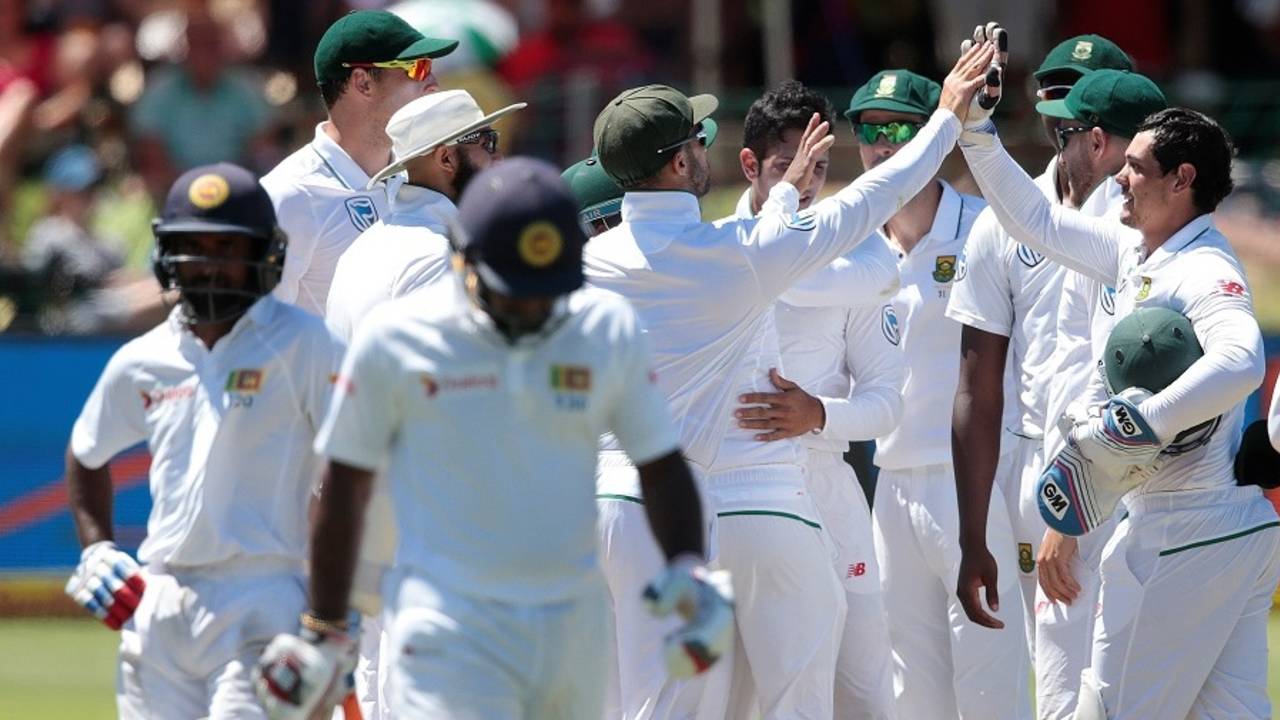Kusal Perera gamble at No. 3 pays meagre dividends
Sri Lanka rolled the dice in August by slotting Kusal Perera at No. 3, but eight innings in, his claim to the position may be in doubt after twin failures at Port Elizabeth
Andrew Fidel Fernando in Port Elizabeth
29-Dec-2016
Kusal Perera's future at No. 3 looks increasingly blurry after another soft dismissal • AFP
In beholding Sri Lankan cricket's last two decades, a prism of risk versus reward can sometimes be useful.
In February 1996, for example, Sanath Jayasuriya averaged 19.73 as an ODI batsman, and his last ten innings as an opener had yielded 173 runs at a strike rate of 61.
The risk, for Sri Lanka, was looking like lightweights in a showcase tournament they were co-hosting for the first time. In fact, you can imagine the foreign media's paternalistic hand-wringing had Jayasuriya and Romesh Kaluwitharana failed.
"Will Sri Lanka ever graduate from minnowhood?" they might have asked. "Are they diluting the quality of the World Cup? Should Arjuna Ranatunga be covered in oil and rolled down the Lord's slope for this cricketing insolence?"
Yet instead of playing to pre-tournament form, Jayasuriya gave left-arm spinner Richard Illingworth a rough and ready pounding and put Phil de Freitas onto the Faisalabad Stadium's satellite dish.
The reward for Sri Lanka was a semi-final, and two wins later a maiden World Cup title. The reward for ODI cricket was a revolution.
*****
When Muttiah Muralitharan was no-balled on Boxing Day 1995, he had 80 Test wickets at 32.76. Let us, for a moment, forget the myriad island marvels that had even brought Murali to the MCG stage, like how he was probably the world's first wrist-spinning offbreak bowler and also had elbows like a rear-ended fender. Yet, Ranatunga and the entire Sri Lankan establishment formed an unwavering shield around him, knocking back jibe after jibe for years until the science caught up and he was, at least officially, redeemed.
But the risk, for Sri Lanka, was their becoming a global cricket joke. No one in cricket's pre-biomechanics age could deny that Murali looked like he was chucking. He looked like a javelin thrower if the javelin thrower had multiple joints in his arm. All Sri Lanka's wins could be made to seem illegitimate. Routinely were they accused of being cheats.
Meanwhile, the reward for Sri Lanka was its most joyful sporting career. The reward for cricket was the goggle eyes, and its greatest taker of wickets.
*****
In the late 1990s, when Lasith Malinga was playing softball cricket on a Rathgama beach, no one in modern cricket had prospered with a truly round-arm action. Low arms mean inaccuracy, it was thought. In domestic circuits, round-arm bowlers were essentially gimmicks - effective briefly perhaps, but often fading once batsmen became accustomed to their actions.
Yet, bowling coach Champaka Ramanayake took Malinga in and trained him. In Malinga's version of the story, he bowled a trillion back-to-back yorkers at shoes glued to the crease.
The risk was that Sri Lanka may be squandering coaching resources on a bowling experiment that has never been known to work.
The reward for Sri Lanka was a World T20 win, and for world cricket the premier death bowler of the era.
*****
Like Sri Lanka's first-class system, the island's college cricket is also said to be in decline. When Kusal Mendis, winner of the 2013 Schoolboy Cricketer of the Year Award, was picked in the Test squad against West Indies last year, there was, as a result, consternation.
Mendis was 20 at the time, and looked 16. In 13 innings in senior cricket, he had averaged 31.30, with only two scores over fifty.
The risk for Sri Lanka, was the possibility that they may ruin a promising player forever by throwing him into Test cricket, to say nothing of the damage his inclusion could do to an already fragile top order.
The reward for Sri Lanka turned out to be one of the greatest Sri Lankan innings in only Mendis' 14th trip to a Test-match crease. Test cricket got one of its most promising young batsmen. Today he played the team's most fluent innings, hitting 58.
*****
In Test cricket's grand tradition, No. 3 batsmen have been the team's most classically correct. Even in Sri Lanka's history, it is the likes of Kumar Sangakkara, Asanka Gurusinha and Roy Dias who have held it, not Aravinda de Silva, Angelo Mathews or Duleep Mendis.
In putting Kusal Perera in that role, with a young top order around him, Sri Lanka's selectors were breaking with tradition. He bludgeons the ball, rather than times it; explodes at the crease instead of building, or manipulating.
But what if breaking with tradition is sort of your own tradition? What if this tradition has brought great rewards?
The rewards for Sri Lanka might have been a No. 3 who sapped the opening bowlers' momentum, who bullied the opposition, who spread the field and aided even his teammates' advance.
The risk, as it happened in this Test, was two awful cut shots. The reward? Scores of seven and six.
Andrew Fidel Fernando is ESPNcricinfo's Sri Lanka correspondent. @andrewffernando
